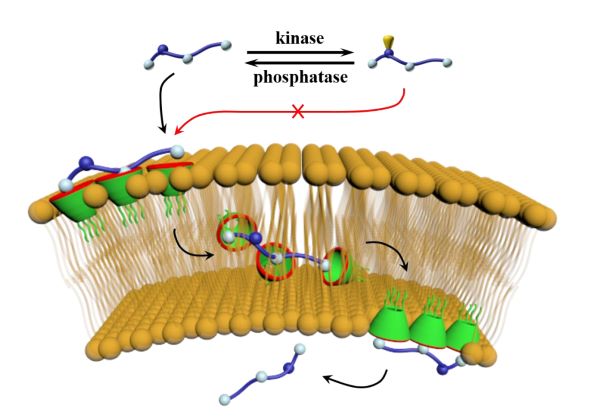Location:首页>Research>Research Interests
3. Bio-membrane transport activated by calixarenes
The discovery of new methods to enter cells without causing significant damage is a great challenge and will contribute to the development of many biomedical fields such as bio-imaging and drug delivery. Cell-penetrating peptides (CPPs) are one of the most popular and efficient vectors for achieving cellular uptake. CPPs are a class of diverse peptides, which can enter the cells by directly crossing plasma membranes and/or endocytosing followed by endosomal escape into cytoplasm. The former way is more efficient than the latter. To improve the transport efficacy, activators have been conceived to accelerate direct translocation across membranes and thus kinetically out-compete endocytosis. The mechanisms of activation can be summarized as: (1) improve the affinity between peptides and membrane, (2) increase membrane fluidity and (3) effect membrane curvature. Our research interest is to engineer novel amphiphilic calixarenes as CPP activators.
Phosphorylation
and dephosphorylation of peptides by kinases and phosphatases is essential for
signal transduction in biological systems, and many diseases involve abnormal
activities of these enzymes. Therefore, the phosphorylation-responsive
supramolecular systems are highly attractive. Our group has introduced
amphiphilic calixarenes as key components to the supramolecular
phosphorylation-responsive membrane transport systems. Thanks to the unique
pre-organized structure and host-guest recognition ability, calixarenes are
nearly 1000 times more active than other established counterion activators. More
intriguingly, two short peptides, which are substrates for kinases, were also
efficiently transported while the respective phosphorylated products were
transported much less efficiently. This directly affords a functional,
label-free kinase assay which is very attractive for drug discovery due to its
potential to be scaled up as a high-throughput screening format. (Angew. Chem. Int. Ed., 2017, 56, 15742–15745, collaborated with Prof. Werner M. Nau and Dr.
Andreas Hennig)



